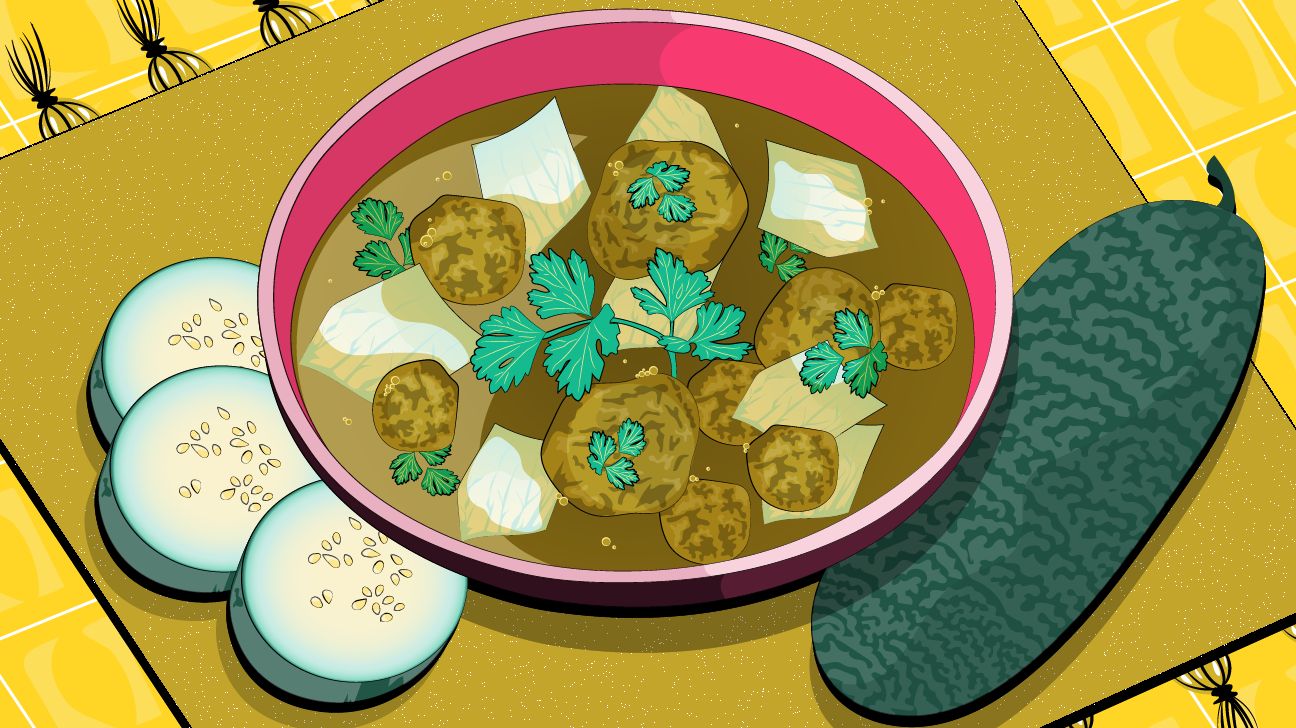When my parents sent me home with the gift of their last winter melon, a 10-pound baby birthed from their garden, it was an undesired responsibility. I’d always thought of the winter melon, with its waxy green skin and pale flesh, as a stodgy old person’s food, robust in size but meek in flavor.
The winter melon entered my life just as I’d reached the stage in quarantine where I’d lost the will to cook. The most kitchen activity I’d done that week was juice oranges into a slurry of pulp. Even eating had become dull. I was familiar with how to prepare a winter melon, so the challenge, then, was to transform this green behemoth into something I’d look forward to eating — something with a little spice and warmth to it.
I cracked the moon flesh of the gourd open on my cutting board. Since winter melon has some natural sweetness, I prepared a savory broth, simmered with chicken bouillon, ginger, and ground white pepper to dial up the warmth and flavor.
To provide some texture against the softness of the melon, I rolled out some pork meatballs and sliced some mushrooms. I tossed in fistfuls of mugwort, chasing the feeling of an old home remedy, its earthiness conjuring up memories of soil, my grandmother’s kitchen, and her tanned palms stirring something before her.
Once it all boiled, I added a pinch of salt for heft and then added even more until I was reminded of why salt was once valued as currency.
The finished soup was hearty and 清 (qing, or “clear,” a valued flavor profile in Southern Chinese cuisine to describe foods that are well balanced, allowing for the essence of the minimal ingredients to shine). The flavors of the broth clung to the melon slices, which dissolved on my tongue first as salty with a slight prickle from the white pepper and then as sweet, the melon flavor peeking out in its true form.
Even when it’s prepared in soup, winter melon has a cool essence that balances out the hot energy that traditional Chinese medicine says accumulates within our bodies from the types of food we eat. I suddenly realized why many Chinese cultures often view food as medicine, believing that recipes can cure sicknesses and improve moods.
As it goes down, the winter melon soup unfurls in my body with warmth. On my kitchen counter, there’s at least 7 pounds of melon left. I can’t believe it, but I’m already looking forward to making another batch of soup for the next time I’m in a funk.
Servings: 6
Ingredients
- 8 ounces ground pork
- 2 egg whites
- 1 tablespoon Shaoxing wine
- 2 teaspoons soy sauce
- 1 teaspoon minced ginger, plus 5 thin medallions of sliced ginger
- 1/2 teaspoon sesame oil
- 1/2 teaspoon salt
- 1/2 teaspoon sugar
- 1/2 teaspoon ground white pepper
- 2 tablespoons water (may need +/- 1 tablespoons
- 1 1/2 pounds winter melon
- 5 cups chicken broth
- 8 ounces mugwort (or leafy green of choice)
- 4 ounces brown mushrooms
Instructions
- Mix pork, egg whites, Shaoxing wine, soy sauce, minced ginger, sesame oil, salt, sugar, and white pepper in a large bowl using chopsticks. Add water 1 tablespoon at a time as needed until mixture thickens into a smooth paste.
- Trim ends off winter melon and peel it. Stand it upright on a cutting board and cut it into 6 wedges. Remove the seeds from the center of each wedge and trim off any excess skin. Cut each wedge into crescent-shaped slices about 1/4 inch thick.
- Bring chicken broth to a boil in a large pot, then add ginger medallions.
- Shape pork paste into meatballs about 1 inch in diameter and drop them in the boiling broth to cook for about 5 minutes. Use a slotted spoon to transfer cooked meatballs to a plate. Set aside.
- Reduce heat to medium and add mugwort, mushrooms, and winter melon to broth. Cook for 5–6 minutes, until melon is translucent and soft.
- Return meatballs to broth, add salt to taste, and boil for 5 more minutes.
- Stir and ladle out to enjoy!
Ying Yu Situ is a writer, educator, and community organizer based in New York. She writes on film, food, and the sensuality of memory.

